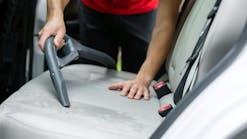Many automotive shop owners get into the business because they are great at what they do. They are excellent at fixing cars, but they may not be so great at managing the business itself. Bill Haas, owner of Haas Performance Consulting, has worked with countless automotive shop owners over the years and one area he finds that they particularly struggle with is the financials.
“These are really smart people. They fix things that may not fixed by anybody else, they are dedicated, hard working, smart, and it’s hard to make that transition of taking that same passion for what we do and apply it to the business of what we do,” Haas said.
In his session at AAPEX on Nov. 4, Haas outlined several key financial strategies for automotive shop owners. For starters, he stressed the importance of understanding your shop’s profit and loss statement (P&L).
“This is how we keep score. This is how we know how well you’re doing in business or get to understand what areas of your business do we need to work on,” he said. “It’s just like playing sports. When we play sports, we keep score – the P&L is the same thing.”
To start with, shop owners need to make sure their P&L is being done correctly. They need to understand where the money is coming from, whether that be labor, parts, sublet, shop supplies, etc., so each of these items need to be broken out on the P&L. This will provide the shop owner with much-needed data.
“Every decision you will make has a financial impact…. So, you better be using data to make your decision. Where’s the data to support your decision? Now you’ve removed the emotion and can use subjectivity to make a decision.”
Pricing and forecasting
Shop owners need to make sure they have the proper pricing structure in place. Overall, they should have 65 percent gross profit. Industry benchmarks indicate a shop needs 70 percent gross profit on labor and 60 percent gross profit on parts. If a shop reaches both of these goals, that will give them 65 percent gross profit overall. To ensure success, a labor markup matrix should be refereed to.
“It looks at different levels of costs of parts and says, ‘Based on what you paid for that part, this is what you should sell the part for,’” Haas explained. “Lower cost parts have a higher markup, higher cost parts have a lower markup, and then you’re looking for the average.”
Shop owners need to prepare for their future with sales forecasting and budgeting. Many shops don’t have sales goals for their company or a budget for new tools and equipment.
“This is a real critical piece that is missing in so many stores. They just accept whatever they get. They do the best they can with whatever happens to happen that year,” Haas said. “But when you do sales forecasting, you can take your historic data and you can now be strategic in saying, ‘This is how much I need to grow this business. What are the areas we need to work on?’”
Shops can then explore different scenarios that will get them closer to their goal. For example, they may want to consider if they need to be more productive in the shop, raise their labor rate, add a new technician, do a better job selling parts, etc.
“With sales forecasting, all of these things start to come to light, and you can have really good conversations,” Haas said.
Around November each year, shops should look at forecasting for the following year, he recommends. This gives the shop a goal and sets expectations not only for the owner, but for all the team members in the shop.
Next, look at the expense side of the business and go through all of the shop’s spending to determine if each item is necessary. Certain costs are likely to increase, such as health insurance and garage liability insurance, but perhaps a shop wants to grow her business and needs to spend a bit of money on marketing, for example. Other costs might include scan tool software updates and equipment repair.
“If it’s necessary fine, then we budget for it,” Haas said. “We come up with, ‘This is what we are going to spend every month in this business.’”
Key performance indicators (KPIs)
All shops need KPIs that they track on a regular basis, such as sales, gross profit, net profit, average hours per repair, and average dollars per repair.
“If I meet a shop owner and I ask what their sales are, they should know their average monthly sales or at least what their sales were last year,” he said. “These things are so easy for then to get because they are built in to reports in every shop management system.”
At the end of his session, Haas left the audience with one final piece of advice: Stop being their own worst enemy and take the time to understand “all of this financial stuff.”
“Understanding financial statements, knowing where the information is, taking the time to evaluate it, it’s important.” he said. “You deserve to be successful, and I define success as having as much money as you need, all your bills are paid on time, your taxes are paid on time, your payroll is covered and you sleep well at night. Because when you work as hard as you do, you deserve that.”



